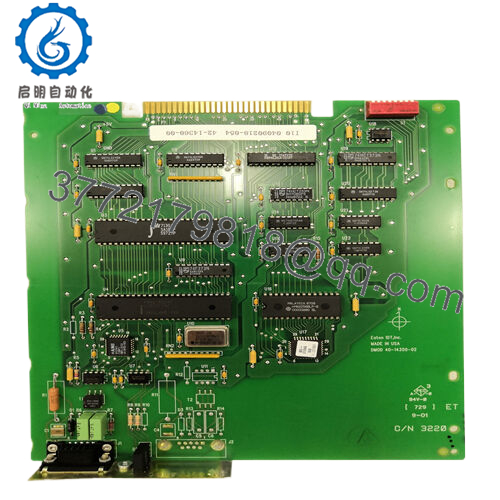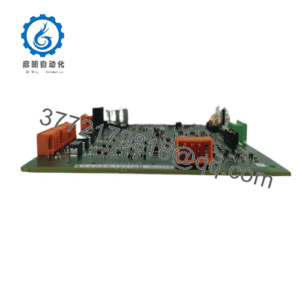Description
Product Model: Schneider 40-14350-02
- Product Brand: Schneider Electric
- Module Type: Industrial communication / interface module
- Key Features (inferred from vendor listings):
1. Interfaces control / automation systems to communication networks (e.g. MODBUS, Ethernet, industrial protocols)
2. Operates on 24 V DC input (typical in industrial modules)
3. Wide operating temperature range (–40 °C to +85 °C) for harsh environments
4. Panel or rack mount capability, suited for DCS / PLC backplane integration
- 40-14350-02
Applications & Industry Context
In industrial automation and process control systems, communication modules are the glue that links field instrumentation, control logic, and supervisory systems (DCS, SCADA, PLC networks). The Schneider 40-14350-02 is marketed as an “industrial control module for computer communication,” indicating it sits at that junction: converting or bridging signals between PLC / DCS logic and network-level protocols.
You might find it used in plants running Schneider / Modicon / Unity PLCs, or in hybrid systems where older control logic needs to talk to newer networks (e.g. Ethernet, Modbus TCP, Profibus, CANopen). Its robust thermal range (–40 °C to +85 °C) suggests use in panel environments subject to temperature cycling or less-than-perfect climate control. Because it is sold as part of DCS / PLC spare parts catalogs, it is likely considered a drop-in module for certain control system frames.
One vendor also lists it under “power supply” categories (which may be mislabeling), but the primary description remains as a communication / control interface module.
In modernization or retrofit projects, putting in a 40-14350-02 may allow older control cabinets to interface more smoothly with Ethernet-based automation networks without full replacement of logic controllers. Because communication standards evolve, having an adaptable interface module helps extend the life of legacy systems.
Role & System Fit
At its core, 40-14350-02 is not a logic controller itself but an interface / communication bridge. Here’s how it typically fits:
- It is installed in a control cabinet or PLC/DCS rack, possibly in a designated module bay or panel slot. Its mechanical design likely supports DIN rail or panel mount, or backplane mounting, although mounting details are not confirmed in the public listings.
- On one side, it connects to internal control logic (PLC, DCS modules, I/O buses, internal buses).
- On the other side, it communicates over external networks or protocols (such as Ethernet, MODBUS, or other industrial protocols) to supervisory systems, SCADA, historian databases, or remote I/O networks.
- It may provide protocol translation, data mapping, buffering, signal isolation, or error checking capabilities — typical for interface modules bridging heterogeneous networks.
- Because it supports a wide temperature range, it may be placed closer to the field or in less-conditioned enclosures, reducing wiring runs.
Given the absence of a detailed datasheet online, one must verify whether 40-14350-02 supports features like protocol conversion (e.g. Modbus RTU ↔ TCP), data buffering, redundancy, local diagnostics, or failover.
Technical Features & (Inferred) Benefits
From the limited vendor information, here are hypothesized features and associated benefits — treat these as assumptions to confirm in practice.
24 V DC Operation
The listing from Hong Kong indicates “Operating Voltage: 24 V DC” — a standard in industrial control modules. Using 24 V DC makes integration easier with PLC power buses and lowers risk of high-voltage faults.
Wide Temperature Tolerance
The module is advertised to duty under –40 °C to +85 °C. That gives robustness for outdoor cabinets, extreme plant environments, or poorly ventilated enclosures.
Support for Multiple Protocols
The vendor listing claims support for Modbus, Profibus, and CANopen. If accurate, this suggests internal protocol stacks and conversion logic, which is valuable in mixed-automation environments. However, such claims should be validated with official Schneider documentation.
Panel / Industrial Form Factor
The module is described as “Industrial Control Module for Computer Communication” and “panel mount.” That suggests relative compactness and design for industrial racks or control panels.
Robust Design & Certification
Vendor material mentions certifications: CE, UL, RoHS. If genuine, those allow for safer deployment in regulated industries and compliance with industrial safety standards.
From these features, one expects functional benefits:
- Less rewriting of legacy logic — interface module handles communication translation
- Lower wiring complexity — consolidate communication interfaces
- Better reliability — designed for industrial ambient extremes
- Easier integration with modern networks (Ethernet, Modbus TCP, etc.) without wholesale system replacement
Technical Specifications Table (Estimated / Inferred)
Because a genuine datasheet was not located, the following table is based on vendor claims and typical interface module norms. Use this as a placeholder to be replaced by exact specs from Schneider or internal documentation.
| Parameter | Specification / Claim / Inference |
|---|---|
| Model / Part Number | Schneider 40-14350-02 |
| Module Type | Communication / Interface / Protocol bridge |
| Input Voltage | 24 V DC (claimed) |
| Operating Temperature | –40 °C to +85 °C (claimed) |
| Communication Protocols | Modbus, Profibus, CANopen (vendor claim) |
| Data Rate | Up to 100 Mbps (vendor listing) |
| Mounting Method | Panel / industrial module mount (claimed) |
| Certifications | CE, UL, RoHS (vendor claim) |
| Country of Origin | France (per listings) |
| Typical Use | DCS / PLC interface, communication bridging, protocol conversion |
Installation & Maintenance Insights
Given what is known (and unknown), here are practical tips and caveats to consider when deploying 40-14350-02 in your systems:
Confirm Functional Role Before Insertion
Because the module’s spec is unclear, ensure you have official product documentation (manual, schematic) before installing. Validate pinouts, input/output sides, power and ground assignments.
Power Supply & Grounding
Use a clean, regulated 24 V DC source (if that is confirmed). Provide proper grounding and shielding to reduce noise, particularly if the module handles network signals or protocol conversion.
Location & Thermal Environment
Mount it in a location with moderate airflow. While it claims –40 to +85 °C tolerance, pushing the limits may degrade components over time. Avoid direct heat sources or enclosures that exceed spec.
Network / Cabling Considerations
Use industrial-grade shielded twisted-pair or fiber cable as applicable. Match impedance, use proper terminations. If the module supports multiple protocols (e.g. RS-485, Profibus, CAN), ensure correct transceiver termination settings (bias resistors, bias voltages, etc.).
Diagnostics & LED / Status Monitoring
Assuming standard design, expect status LEDs (power, network activity, error) to assist during field install. If you don’t see expected LED indications, isolate power or communication issues.
Firmware / Configuration
If this module includes embedded firmware, configuration parameters (network address, protocol mode, mapping) should be backed up. Be careful when updating firmware — ensure compatibility with connected devices.
Spare / Redundancy Strategy
Given the uncertain availability of this part (it appears to be a specialty module), maintain at least one spare 40-14350-02 (or equivalent) in your spare parts inventory.
Validation & Post-Install Testing
Perform full end-to-end tests: send and receive data across each protocol interface, verify mapping, error handling, latency, and resilience to signal loss or power transients.
Document Everything
Because the module lacks widespread public documentation, record wiring diagrams, signal mapping, and firmware versions in your site records. Future maintenance will rely heavily on your documentation.



 WhatsApp: +86 16626708626
WhatsApp: +86 16626708626 Email:
Email:  Phone: +86 16626708626
Phone: +86 16626708626


